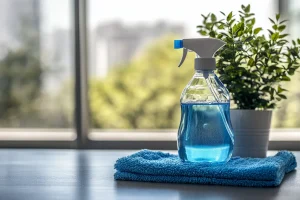Aluminum pots and pans are staples in many kitchens, prized for their light weight, excellent heat conductivity, and often, their affordability. This combination makes them a true workhorse, capable of handling a wide array of culinary tasks. However, to keep these valuable tools in prime condition, understanding their unique characteristics and care requirements is essential. While incredibly useful, aluminum is a softer metal that can be reactive, meaning it needs a gentler touch and specific cleaning methods compared to some other cookware materials.
Proper care not only maintains the appearance of your pans but also preserves their cooking performance and extends their lifespan, ensuring they remain a reliable part of your kitchen for years to come.
Contact us!
1. Know Your Metal: A Closer Look at Aluminum Cookware
Before diving into cleaning techniques, it’s beneficial to understand the type of aluminum cookware one might have, as this can influence its care. The inherent properties of aluminum, particularly its reactivity, are central to why specific cleaning and usage guidelines are recommended.
Not All Aluminum is Created Equal
Aluminum cookware comes in several forms, each with slightly different surface characteristics:

- Raw/Uncoated Aluminum: This is aluminum in its most basic form. It is the most susceptible to scratching, staining, and reacting with certain foods. While an excellent heat conductor, it requires the most careful handling and cleaning.
- Anodized Aluminum: This type of aluminum has undergone an electrochemical process that hardens its surface, creating a layer that is significantly more durable and less reactive than raw aluminum. This anodized layer acts as a barrier, reducing the likelihood of the aluminum leaching into food and making the cookware more resistant to scratches and corrosion. This makes it a more forgiving option, especially when cooking acidic ingredients.
- Non-Stick Coated Aluminum: Many non-stick pans use an aluminum base for its heat distribution properties, with a non-stick coating applied to the cooking surface. For these pans, cleaning methods must prioritize the preservation of this delicate coating, as harsh abrasives can easily damage it.
Identifying the type of aluminum cookware is a foundational step because the material’s surface dictates its interaction with food, its vulnerability to damage, and consequently, the most appropriate cleaning strategies and preventative measures. For instance, the anodization process directly alters the aluminum’s surface to be less reactive, which is why anodized aluminum is often recommended for cooking acidic foods.
The Science Bit: Why Aluminum Reacts
Aluminum is classified as a “reactive metal”. This means it has a tendency to undergo chemical reactions when it comes into contact with certain substances. Most notably, aluminum can react with highly acidic foods (like tomatoes, vinegar, or citrus fruits) and strongly alkaline substances (found in some harsh detergents).
This reactivity can lead to several outcomes:
- Discoloration: The pan itself might discolor, or it could cause discoloration in the food being cooked.
- Metallic Taste: Sometimes, a metallic taste can be imparted to foods, particularly acidic ones, cooked in reactive aluminum.
- Aluminum Leaching: The reaction can cause trace amounts of aluminum to migrate from the pan into the food. It’s important to note that everyday exposure to aluminum through cookware has not been linked to significant health risks by current research, and organizations such as the Alzheimer’s Association have found no solid evidence connecting aluminum cookware to Alzheimer’s disease.
Understanding this reactivity is key to preventing unwanted changes to both the cookware and the food. Consumers who are aware of these differences can also make more informed purchasing decisions, selecting cookware that aligns with their cooking habits and their commitment to its upkeep.
2. Everyday Sparkle: Routine Cleaning for Your Aluminum Pans
Consistent and gentle daily cleaning is the cornerstone of maintaining aluminum cookware. These routine practices are far more effective in the long term than resorting to aggressive methods to fix problems that could have been prevented.
The Golden Rule: Cool, Soak, and Gentle Scrub
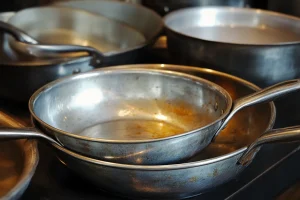 A simple three-step process is recommended for everyday cleaning:
A simple three-step process is recommended for everyday cleaning:
- Cool Down First: Always allow aluminum pots and pans to cool completely before introducing them to water. Exposing hot cookware to cooler water can cause thermal shock, potentially leading to warping or other damage.
- The Gentle Soak: Once cool, soak the cookware in warm water with a few drops of mild dish soap. This helps to loosen any food particles without requiring harsh scrubbing.
- Soft Touch Only: Use a soft sponge, cloth, or non-abrasive pad to gently scrub away food residue. This approach effectively cleans without scratching the aluminum surface.
First Impressions: Prepping New Aluminum Cookware
When introducing new aluminum cookware to the kitchen, a few initial steps can ensure it’s ready for use and help maintain its condition from the start:
- Label Removal: Carefully remove any manufacturer’s labels. To avoid scratching the new surface, use a non-metallic utensil (like a plastic scraper or even a fingernail) to gently lift the corners of the label. For any stubborn adhesive residue, a bit of rubbing alcohol on a soft cloth can be effective. It’s crucial to avoid knives or other metal tools for this task, as they can easily scratch the aluminum.
- Initial Wash: Before its first use, wash the new cookware with warm water, a mild dish soap, and a non-abrasive sponge to remove any dust or residues from manufacturing and packaging.
- Seasoning/Pre-treatment (Optional but Recommended for some types):
- For new aluminum frying pans (particularly raw aluminum), a simple pre-treatment can be beneficial. Heat a small amount of cooking oil in the pan over low heat for a few minutes. Then, let it cool and wash it again with mild soap and water. This can help create a more non-stick surface initially.
- For new aluminum pots, boiling water in them for about twenty minutes serves a dual purpose: it can help remove any residual manufacturing oils or substances and may also help to disinfect the pot and reduce the likelihood of limescale buildup from the outset.
The Finishing Touch: Drying and Preventing Water Woes
Proper drying is a critical, yet often underestimated, step in aluminum cookware care:
- Thorough Drying is Key: Immediately after washing and rinsing, aluminum cookware should be dried thoroughly with a soft cloth or dish towel. Aluminum is susceptible to developing water spots or even limescale (mineral deposits) if left to air dry, especially in areas with hard water.
- This simple act of drying prevents issues that would otherwise necessitate more intensive cleaning efforts later on.
Establishing these daily habits—allowing pans to cool, using gentle washing techniques, and always drying thoroughly—not only keeps aluminum cookware looking its best but also significantly contributes to its longevity and functional performance. Neglecting these steps, such as leaving food to dry onto the surface or allowing pans to remain wet, directly contributes to problems like hardened residues and mineral buildup, which then demand more vigorous (and potentially damaging) cleaning interventions.
3. Tackling Tough Messes: Restoring Your Aluminum’s Glory
Despite diligent daily care, aluminum pots and pans can sometimes encounter more stubborn issues like burnt-on food, tough stains, discoloration, or oxidation. Fortunately, many of these can be addressed effectively using gentle, often common, household ingredients and a bit of patience, underscoring that harsh chemical cleaners are frequently unnecessary and can even be detrimental.
Banishing Burnt-On Food: Gentle Persuasion Required
When food gets unfortunately scorched onto the surface of an aluminum pan, resist the urge to immediately attack it with an abrasive scrubber.
- The Boiling Water Trick: A primary and effective first step is to fill the affected pot or pan with enough water to cover the burnt areas. Bring the water to a boil and let it simmer for several minutes. The heat and moisture will help to loosen the tenacious food particles.
- Baking Soda to the Rescue: After the boiling water has worked its magic, turn off the heat. Carefully add a generous amount of baking soda (a few tablespoons, depending on the pan size and severity) to the hot water. Allow this solution to sit for a period, from 30 minutes to a few hours, or even overnight for very stubborn cases. Baking soda is mildly abrasive and alkaline, helping to lift the burnt residue without scratching the aluminum. Once soaked, gently scrub the loosened debris with a non-abrasive sponge or scrubber.
- Wooden Spoon Assist: For particularly stubborn, chunky bits of burnt food that remain after soaking or boiling, a wooden spoon or a plastic spatula can be used to gently dislodge them without harming the pan’s surface.
Conquering Stains and Discoloration: Natural Brighteners
Aluminum can sometimes develop stains or a general discoloration from certain foods or minerals in water. Several natural acidic cleaners can help restore its brightness.
- Acidic Powerhouses – Lemon Juice & Vinegar:
- Method: To treat discoloration or stains, fill the pot or pan with water and add approximately 1 to 2 tablespoons of white vinegar or fresh lemon juice for each quart of water used. Bring this acidic solution to a boil and let it simmer for 10 to 15 minutes. The mild acid helps to lift the discoloration and dissolve mineral deposits. After simmering, allow the solution to cool, then pour it out and wash the pan as usual.
- Alternative for Hard Water Stains: If hard water is leaving chalky deposits, a solution of equal parts white vinegar and water can be poured into the pan to cover the stained areas. For light stains, let it soak for about 30 minutes. For heavier deposits, bring this mixture to a boil and simmer for 10-15 minutes before rinsing and drying.
- Cream of Tartar – The Classic Restorer: Cream of tartar (potassium bitartrate), a byproduct of winemaking, is another excellent acidic cleaner for aluminum.
- Boiling Method: Add 2 tablespoons of cream of tartar per quart of water to the stained aluminum pan. Bring the mixture to a boil and let it simmer for 10 to 15 minutes. The stains should lift, and the aluminum should appear brighter. Let cool, discard the solution, and wash as usual.
- Paste Method: For targeted stain treatment, create a paste by mixing a few tablespoons of cream of tartar with a few drops of water. Apply this paste directly to the stained areas, let it sit for 10-15 minutes (or longer for stubborn stains), and then gently scrub with a non-abrasive sponge. Rinse thoroughly and dry.
- The Salty Solution (for specific residues): For some types of built-up food debris, filling the pan with water, adding a few tablespoons of table salt, bringing it to a boil, and letting it simmer for a few minutes can be effective. Allow the pan to cool, then wipe it clean with a non-abrasive sponge.
Dealing with Oxidation (That Chalky, White Buildup)
Oxidation is a common occurrence with aluminum, appearing as a dull, chalky, or white film on the surface. This is a natural reaction of the metal to oxygen and moisture in the air.
- Removal Techniques: The same acidic solutions used for stains and discoloration are highly effective for removing oxidation. Boiling a solution of water with vinegar, lemon juice, or cream of tartar, as described above, is a primary method. A paste made from baking soda mixed with lemon juice can also be applied to oxidized areas, allowed to sit, and then gently scrubbed off.
Polishing for a Like-New Shine (Beyond Basic Cleaning)
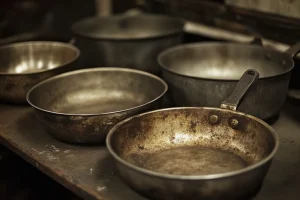 Once clean, an extra step can restore a brighter shine to aluminum cookware.
Once clean, an extra step can restore a brighter shine to aluminum cookware.
- Natural Polishing: For a quick polish, occasionally wipe the surface of the clean, dry aluminum pan with a soft cloth dampened with a small amount of white vinegar or lemon juice. Rinse thoroughly with clean water and dry completely to prevent new water spots.
- Commercial Aluminum/Metal Polish (Use with Caution):
- Several commercial polishes are available that are formulated for aluminum or various metals, including aluminum. These are typically used on the exterior of pans to enhance their shine. For instance, some sources suggest silver polish for exteriors , while specific aluminum restoration solutions also exist.
- It is crucial to always test any commercial polish on a small, inconspicuous area first. Carefully follow the product’s instructions, and ensure it is food-safe if there’s any chance of it contacting cooking surfaces (though most are designed for exterior use).
The chemical properties of these mild acids (vinegar, lemon juice, cream of tartar) work by reacting with and dissolving the compounds that cause oxidation and many types of stains. Baking soda, with its gentle abrasive quality and alkaline nature, helps to physically lift grease and food particles. Heat, particularly from boiling water, acts as a catalyst, speeding up these cleaning reactions. The consistent success of these gentle, readily available household items demonstrates that effective cookware care can be both safe and economical, reducing the need for harsh, potentially damaging commercial cleaners and promoting a more sustainable approach in the kitchen. Many of these cleaning issues share common origins, such as prolonged food contact or mineral reactions, which is why a versatile set of gentle solutions can address a wide range of problems.
Key Table 1: Common Aluminum Woes & DIY Fixes At-a-Glance
| The Issue | Recommended DIY Solution(s) | Key Ingredients/Tools |
|---|---|---|
| Light Food Residue | Soak & mild soap; gentle scrub | Mild dish soap, soft sponge/cloth |
| Burnt-On Food | Boil water, then add baking soda & let soak; gentle scrub | Water, baking soda, non-abrasive scrubber, wooden spoon |
| Mild Stains/Discoloration | Boil with vinegar/lemon juice solution; Cream of tartar paste | White vinegar, lemon juice, cream of tartar, non-abrasive sponge |
| Hard Water Spots | Boil or soak with vinegar/water solution | White vinegar, water |
| Oxidation (Chalky Film) | Boil with vinegar/lemon juice/cream of tartar solution; Baking soda & lemon juice paste | Vinegar, lemon juice, cream of tartar, baking soda |
| Dull Surface | Wipe with cloth dampened with vinegar/lemon juice; rinse & dry | White vinegar, lemon juice, soft cloth |
4. The “Handle with Care” List: What to Absolutely Avoid with Your Aluminum
While aluminum is a versatile cookware material, its relatively soft and reactive nature means certain cleaning agents and tools can cause significant, often irreversible, damage. Understanding why these items are harmful is crucial for protecting your investment.
The Abrasive Attack: Enemies of Smooth Surfaces
Physical abrasion is a primary enemy of aluminum cookware’s finish.
- Steel Wool and Scouring Powders: These items are far too harsh for aluminum. They will inevitably scratch and dull the surface, whether it’s raw, anodized, or even the surrounding areas of non-stick cookware.
- Metal Utensils for Cleaning (Knives, Scrapers): Using knives, metal spatulas, or other sharp metal tools to scrape away stuck-on food is a sure way to gouge and deeply scratch the softer aluminum.
- The Damage Done: Scratches are not merely cosmetic. They can make the pan more difficult to clean in the future as food particles get trapped in the crevices. For anodized aluminum, deep scratches can compromise the protective hardened layer, exposing the more reactive aluminum underneath. For non-stick surfaces, scratches can lead to the coating flaking off. Furthermore, a scratched surface can sometimes increase the reactivity of the aluminum itself.
Chemical Warfare: Harsh Cleaners to Shun
Strong chemicals can react aggressively with aluminum, leading to serious damage.
- Bleach and Oven Cleaners: These substances are highly corrosive and should never be used on aluminum cookware. They can cause severe discoloration, create pits in the metal, and completely ruin any non-stick coatings or anodized finishes. The damage from such potent chemicals is often permanent.
- Harsh Dish Soap Detergents (Acidic/Hydrochloric): Some dishwashing detergents, particularly some designed for automatic dishwashers or heavy-duty cleaning, may contain aggressive acidic or alkaline chemicals (sometimes listed as “hydrochloric” or similar) or high concentrations of salt. These can lead to discoloration, corrosion, and pitting of aluminum surfaces. It is advisable to read detergent labels carefully or, to be safe, stick with mild, pH-neutral dish soaps for handwashing aluminum.
The Acidic Food Conundrum: A Delicate Balance
As previously discussed, aluminum’s reactivity with acidic foods requires careful management.
- Why the Reaction? Aluminum readily interacts with acidic ingredients like tomatoes, tomato-based sauces, vinegar, citrus juices, and wine.
- Potential Consequences:
- Pitting and Discoloration: Prolonged contact, especially during long simmering or storage, can cause the pan’s surface to become pitted or discolored. The food itself might also change color.
- Metallic Taste: Acidic foods cooked in reactive aluminum can sometimes develop an undesirable metallic flavor.
- Aluminum Leaching: While trace amounts of aluminum can migrate into food, particularly acidic or salty foods, it’s worth reiterating that current research has not established a link between this everyday exposure through cookware and significant health risks.
- Smart Strategies for Acidic Foods:
- Opt for Anodized or Coated Aluminum: These types are specifically designed to be less reactive and are better choices for cooking acidic dishes.
- Minimize Contact Time: Avoid cooking acidic foods for very extended periods in uncoated aluminum. Crucially, never store acidic foods in any type of aluminum cookware; transfer leftovers to glass or plastic containers immediately.
- Consider Alternatives: For dishes that are highly acidic and require long cooking times, cookware made from non-reactive materials like stainless steel, glass, or ceramic-coated pans might be a preferable choice, especially if only uncoated aluminum is available.
Heat Extremes and Dishwasher Dangers
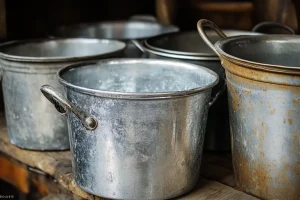 Managing temperature, both in cooking and cleaning, is also important.
Managing temperature, both in cooking and cleaning, is also important.
- Mind the Heat: While aluminum is an excellent heat conductor, subjecting it to excessively high cooking temperatures can lead to discoloration or even warping, especially with thinner gauge pans. Using medium heat settings is generally recommended for most cooking tasks in aluminum pans.
- The Dishwasher Debate (Mostly a “Don’t”):
- The combination of high water temperatures, prolonged exposure to moisture, and harsh, often alkaline, dishwasher detergents creates an aggressive environment that can severely damage aluminum cookware. This typically results in the aluminum darkening, becoming discolored, pitted, or developing a chalky residue.
- Handwashing with mild soap and a soft sponge is consistently the strongly recommended method for cleaning aluminum pots and pans to preserve their finish and integrity.
A single misstep with a harsh chemical or an overly abrasive tool can inflict lasting harm on an aluminum pan. This underscores the importance of informed care, based on an understanding of aluminum’s inherent properties. The softness of the metal makes it vulnerable to physical damage, while its reactivity makes it susceptible to chemical attack.
Key Table 2: Aluminum Cookware Cleaning: Do’s and Don’ts Quick Guide
| Safe for Aluminum (DO USE) | Harmful to Aluminum (DON’T USE!) |
|---|---|
| Mild dish soap | Steel wool, scouring powders, abrasive pads |
| Soft sponges, cloths, non-abrasive scrubbers | Metal scrapers, knives, or other sharp metal tools (for cleaning) |
| Warm water | Bleach, oven cleaners |
| Baking soda (for cleaning pastes/soaks) | Harsh chemical detergents (e.g., some dishwasher detergents, those with strong acids/alkalis) |
| White vinegar, lemon juice, cream of tartar (for stains/oxidation) | Automatic dishwasher (generally causes darkening, pitting, discoloration) |
| Wooden, silicone, or heat-resistant plastic cooking utensils | Prolonged cooking or storage of highly acidic or salty foods (especially in uncoated aluminum) |
| Thorough drying after washing | Very high, uncontrolled cooking heat |
5. Long-Term Love: Proactive Care and Smart Storage for Lasting Luster
Beyond the immediate cleaning process, proactive measures in daily use and storage play a significant role in preserving the condition and extending the lifespan of aluminum cookware. These often-overlooked aspects of care are just as crucial as the washing techniques themselves.
Utensil Wisdom: Your Pan’s Best Friends
The tools used during cooking can have a direct impact on the surface of aluminum pans.
- To prevent unsightly scratches and maintain the integrity of the cooking surface, especially for raw or anodized aluminum, it is strongly recommended to use utensils made from wood, silicone, or heat-resistant plastic. These materials are far gentler on aluminum than metal utensils like stainless steel spoons or spatulas, which can easily scratch the relatively soft metal.
Nesting Nightmares: Smart Storage Solutions to Prevent Scratches
How aluminum pots and pans are stored can significantly affect their condition. Careless stacking is a common cause of scratches and dings.
- Avoid Stacking Directly: Whenever possible, try to avoid stacking aluminum pans directly inside one another. The friction and pressure from nesting can lead to scratches on both the interior and exterior surfaces.
- Protective Barriers: If stacking is unavoidable due to space constraints, always place a protective barrier between each pan. Soft cloths, paper towels, or commercially available felt or fabric pan protectors work well to cushion the pans and prevent them from scraping against each other.
- Hanging Racks: Installing a pot rack to hang aluminum cookware is an excellent storage solution. It not only frees up valuable cabinet space but also keeps pans separated, preventing contact scratches and allowing air to circulate. This method also keeps them easily accessible.
- Drawer Dividers: If storing pans in drawers, consider using drawer dividers specifically designed for cookware. These keep items separated, preventing them from shifting and knocking against each other when the drawer is opened or closed, thus minimizing scratches.
- Adjustable Wire Racks: Vertical storage using adjustable wire racks, often placed inside cabinets, can also be effective. These racks allow pans, especially frying pans and lids, to be stored on their sides, reducing surface contact.
- Soft-Close Hardware & Gripper Pads: For those planning a new kitchen or a remodel, investing in soft-close hardware for cabinets and drawers can be a worthwhile consideration. This feature prevents drawers from slamming shut, reducing the risk of pans being jolted and damaged. Additionally, lining drawers or shelves with gripper pads can prevent pans from sliding around, offering further protection against scratches.
Regular Inspection
It’s a good practice to occasionally inspect aluminum pans for any signs of deep scratches, significant pitting, or warping. While minor wear is normal, extensive damage can affect cooking performance (e.g., uneven heating due to warping) and make pans more difficult to clean effectively.
Adopting these proactive habits—choosing appropriate utensils and implementing thoughtful storage solutions—shifts the focus from merely reactive cleaning to ongoing preservation. This approach not only maintains the aesthetic appeal of the cookware but also safeguards its functional qualities, ultimately extending its useful life, saving money in the long run, and reducing the need for premature replacement.
6. When Your Pans Need More Than Elbow Grease: Considering Professional Options
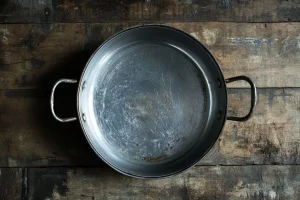 There may come a time when, despite best efforts with home cleaning methods, an aluminum pot or pan presents a challenge that seems insurmountable. The question then arises: are there professional cleaning or restoration services available for household aluminum cookware, and when might it be appropriate to consider such an option?
There may come a time when, despite best efforts with home cleaning methods, an aluminum pot or pan presents a challenge that seems insurmountable. The question then arises: are there professional cleaning or restoration services available for household aluminum cookware, and when might it be appropriate to consider such an option?
The Reality for Household Aluminum Cookware
It is important to set realistic expectations regarding professional restoration for typical household aluminum pots and pans.
- Limited Specialized Restoration Services for Household Aluminum: Unlike materials such as cast iron, for which dedicated restoration services exist , specialized services for refinishing or extensively restoring general household aluminum cookware are not widely available. Many cookware restoration specialists explicitly state that they do not service aluminum items, focusing instead on materials like seasoned cast iron or carbon steel.
- Commercial vs. Household Focus: Many services that do offer “professional cookware cleaning” and recoating, such as Pan Glo, are primarily geared towards commercial and industrial clients, like bakeries. Their processes often involve heavy-duty equipment like hydraulic presses for straightening pans and industrial ovens for curing specialized coatings. These services and their associated costs are generally not designed for, nor easily accessible to, the average home cook with a few aluminum pans.
When Might “Professional” Intervention Make Sense for Home Users?
While sending a typical aluminum frying pan out for a full professional restoration is unlikely, there are nuanced scenarios or alternative interpretations of “professional help”:
- Severely Neglected or Damaged Pans: If an aluminum pan is extremely heavily soiled with layers of burnt-on carbon and grease, or exhibits severe oxidation that repeated and varied DIY methods have failed to resolve, one might theoretically seek a specialized cleaning service. However, the cost-effectiveness of such an endeavor for a standard aluminum pan would need careful consideration against the price of replacement. Some online discussions among cookware enthusiasts mention extreme measures like using “Carbon Off” (marketed as safe for aluminum) or ammonia fumes for very heavy buildup, but these are potent chemical approaches often considered last resorts.
- High-Value or Sentimental Pieces: If a particular aluminum pan holds significant sentimental value, or if it is a rare, vintage, or high-cost artisanal piece, a user might explore local metal polishing or general metal restoration services (even those not specifically advertising for cookware). They might be able to offer cleaning or polishing, but this would be a niche inquiry.
- Using Professional-Grade Products (DIY): Perhaps a more practical interpretation of “professional help” for home users involves utilizing specialized, professional-grade cleaning or restoration products that are available for consumer purchase.
- For example, companies like AL-NEW offer aluminum restoration solutions designed to remove chalky oxidation from outdoor aluminum items like patio furniture and fixtures. While not specifically for cookware, and with some user reports indicating results can be temporary , such products demonstrate the availability of stronger chemical solutions.
- All-Clad, a cookware manufacturer, also offers a cleaner and polish suitable for both stainless steel and aluminum, made from natural minerals and designed to bring out luster. This is applied by the user.
- It is critical to remember that these are still DIY applications, and product instructions must be followed meticulously, especially concerning food safety if used on cooking surfaces.
Benefits Often Associated with Professional (Commercial) Services
The advantages highlighted by commercial cookware cleaning services, such as extended pan lifespan, increased operational efficiency, and enhanced safety through grease elimination , are highly relevant in a high-volume commercial setting where cookware undergoes intensive daily use and where equipment downtime or product inconsistency has significant financial implications. For a home user, the marginal extension of a pan’s life from a hypothetical (and likely costly) single professional clean might not outweigh the benefits of consistent, good home care or the cost of replacement for a standard pan.
The Bottom Line for Most Home Cooks
For the vast majority of aluminum pots and pans found in home kitchens, diligent adherence to the DIY cleaning, care, and preventative strategies detailed in this guide will be sufficient to maintain them in good condition for many years.
If a standard aluminum pan becomes severely damaged (e.g., deeply pitted, warped beyond usability) or so intractably soiled that even robust DIY methods prove futile, replacement is often the most practical and economically sensible course of action for household items.
Therefore, “calling a professional” in the context of household aluminum cookware is less about seeking an external cleaning service and more about:
- Recognizing Limitations: Understanding when a pan has reached the end of its practical lifespan or is beyond reasonable DIY repair, and making an informed decision to replace it.
- Strategic Product Use: Considering the use of a more potent, specialized consumer cleaning or polishing product for a particularly stubborn issue, such as heavy exterior oxidation, after exhausting gentler methods.
- Realistic Expectations: Acknowledging that the intensive restoration services advertised are typically aimed at other cookware materials (like cast iron) or cater to the distinct needs and scales of commercial operations.
Ultimately, the best approach for most aluminum cookware owners is a combination of informed daily care, effective DIY solutions for common problems, and a realistic understanding of when a pan is better retired than subjected to extraordinary (and potentially costly or unavailable) interventions. Consistent good care is the most reliable path to long-lasting, gleaming aluminum cookware.




